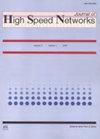Energy efficiency of cache collaboration in core content distribution networks
IF 1
Q4 COMPUTER SCIENCE, INFORMATION SYSTEMS
引用次数: 0
Abstract
With escalating demands for high-definition video, cache collaboration allows neighbor nodes to share locally stored content in order to reduce download traffic. High energy consumption associated with content delivery remains a concern for Content Distribution Networks (CDNs). Therefore, this paper proposes cluster-based collaborative caching in a core network employing IP over WDM. The aim is to allow sets of core caches to fully share content while minimizing power. A Mixed Integer Linear Programming (MILP) model is used to form energy-efficient cache clusters. The energy consumption of the network is evaluated under different cluster sizes to find the optimum size that minimizes energy. To evaluate the influence of content popularity distribution, a heavy-tailed Zipf distribution and an Equal popularity distribution are evaluated. In addition, the work investigates the influence of downlink traffic behavior and power consumption parameters on optimum cluster sizes. Attained results reveal that maximum savings in energy consumption introduced by cluster-based collaborative caching are up to 34.3% and 21.8% under the Zipf and Equal distribution, respectively. Cache collaboration is not recommended when all core nodes contain fully replicated content servers. Results also show that power consumption parameters do not influence cluster formation. It is recommended keeping cache collaboration in the core network simple, so as to reduce intra-cluster communication.核心内容分发网络中缓存协作的能源效率
随着对高清视频的需求不断增加,缓存协作允许相邻节点共享本地存储的内容,以减少下载流量。与内容交付相关的高能耗仍然是内容分发网络(cdn)关注的问题。因此,本文提出了一种基于IP over WDM的核心网集群协同缓存技术。其目的是允许核心缓存集在最小化功耗的同时完全共享内容。采用混合整数线性规划(MILP)模型形成高效节能的缓存簇。通过对不同簇大小下的网络能耗进行评估,找到能量最小的最优簇大小。为了评估内容流行度分布的影响,评估了重尾Zipf分布和等流行度分布。此外,本文还研究了下行流量行为和功耗参数对最优簇大小的影响。所获得的结果表明,在Zipf和Equal分布下,基于集群的协作缓存带来的最大能耗节约分别高达34.3%和21.8%。当所有核心节点都包含完全复制的内容服务器时,不建议使用缓存协作。结果还表明,功耗参数不影响集群的形成。建议将核心网的缓存协作保持简单,以减少集群内的通信。
本文章由计算机程序翻译,如有差异,请以英文原文为准。
求助全文
约1分钟内获得全文
求助全文
来源期刊

Journal of High Speed Networks
Computer Science-Computer Networks and Communications
CiteScore
1.80
自引率
11.10%
发文量
26
期刊介绍:
The Journal of High Speed Networks is an international archival journal, active since 1992, providing a publication vehicle for covering a large number of topics of interest in the high performance networking and communication area. Its audience includes researchers, managers as well as network designers and operators. The main goal will be to provide timely dissemination of information and scientific knowledge.
The journal will publish contributed papers on novel research, survey and position papers on topics of current interest, technical notes, and short communications to report progress on long-term projects. Submissions to the Journal will be refereed consistently with the review process of leading technical journals, based on originality, significance, quality, and clarity.
The journal will publish papers on a number of topics ranging from design to practical experiences with operational high performance/speed networks.
 求助内容:
求助内容: 应助结果提醒方式:
应助结果提醒方式:


